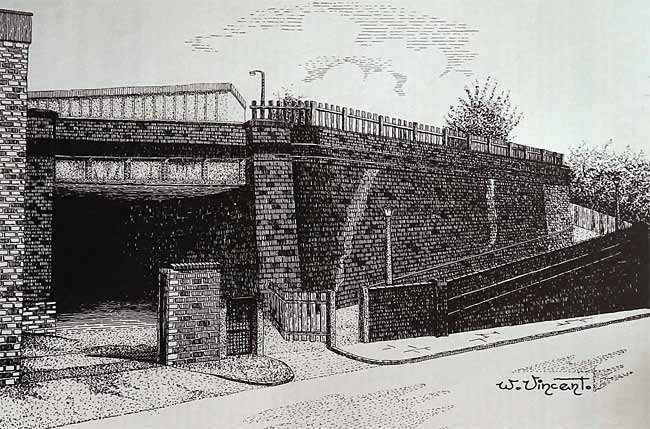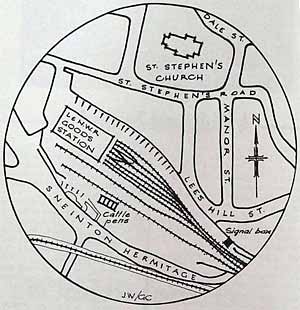< Previous
Gone, but not forgotten...
Stephen Best tells how a 19th century railway company ventured into Sneinton.
 Remains of Manvers Street Station showing Cattle Ramp and Access Tunnel.
Remains of Manvers Street Station showing Cattle Ramp and Access Tunnel. In the nineteenth century many of the great towns of England saw the rival railways scrambling for the lucrative business they afforded. During the 1870's the Midland and the Great Northern had the Nottingham traffic, with their stations on Station Street and London Road. In 1879, however, another of the major companies obtained a toehold in the town. This was the London and North Western, whose joint line with the G.N.R. opened from Saxondale Junction on the Grantham line to Welham Junction near Market Harborough.
This route made possible the running of through trains from Nottingham to Melton Mowbray, Market Harborough, and Northampton, which was in the heart of L.N.W.R. territory. From Saxondale the London and North Western had running powers over the Great Northern to that company's London Road station, and the use of part of that terminus for handling goods traffic.
There being no possibility of improving their goods facilities at London Road, the authorities at Euston decided to establish a freight railhead of their own in Nottingham. Much the greater part of railway revenue came from goods traffic, so it is not surprising that the Company should have considered a freight-only depot worthwhile.

The site chosen was one of about five acres between Sneinton Hermitage and Newark Street, a little to the south of St. Stephen’s church. The land, owned principally by Earl Manvers, was not built up when the work began in 1886, but even so the engineering works were described by the Nottingham Evening Post as 'decidedly stiff.' The half mile long branch was built in a north-westerly direction from Trent Lane Junction on the Nottingham-Grantham line. For about two thirds of this distance it was carried on an embankment, Meadow Lane being spanned by a handsome brick arch bridge wide enough for five tracks, although only four were laid. Sneinton Hermitage was crossed at an angle by an iron girder bridge, and it was here that old Sneinton suffered some casualties. The rock houses on the Hermitage in the way of the bridge had to go, together with Lund's allotment gardens which were obliterated. The sandstone rock at the end of the line was reduced in height by some 25 feet by shot firing it, cutting the stone to manageable size, and carting it a short distance to form the embankment. The bottom end of Lees Hill, which until then ran down to the Hermitage, had to be diverted to the route subsequently followed by Lees Hill Footway. The main building at the station was the large warehouse into which four railway tracks ran. On either side of the warehouse were three projecting crane hoods and a covered canopy under which road vehicles could be loaded and unloaded. Access was from Manvers Street and Newark Street, and a feature of the layout was the roadway passing under one end of the warehouse, enabling drays to be loaded through the floor of the building itself.
From the Manvers Street entrance a cattle ramp led up to the goods yard.
The station offices were at the Newark Street gate, with stables nearby for twenty five horses.
In May 1887 the Evening Post sent a reporter to describe the progress of the works. He noted that even with 120 men engaged at the Newark Street end of the project, construction work was 'exceedingly tedious', with about 100,000 cubic yards of material to be excavated and embanked. The paper stated that the L.N.W.R. had not ventured on this undertaking lightly, and remarked that the Company's possession of its own headquarters in the town held great potential for tapping a promising and unprovided-for area. The proximity of such important factories as I. & R. Morleys was pointed out in this connection.
Grazing into his crystal ball the reporter suggested that 'Indirectly, the extension may help, in no small measure, to bring within the range of practicability the scheme for the establishment of a central station, which on all sides is admitted to be one of the pressing needs of Nottingham.' It is evident that the railway company and the contractors were fighting a losing battle with gossip and rumour, for, the paper concluded peevishly, 'An idea has gained ground in the locality that there is to be a passenger station in Newark Street, and despite repeated contradictions, the notion is adhered to with a strange perversity.'
The station opened on July 2nd, 1888 without any kind of ceremony. The first train had arrived for unloading at 5 o'clock on the previous morning, and the initial traffic consisted of three trains in and four out daily. From this date all L.N.W.R. goods trains were handled at Manvers Street, although its passenger services continued to use London Road. Indeed, on the opening of Victoria Station in 1900 the London and North Western rather oddly did not seek running powers into this smart and conveniently situated new station, and the passenger trains from Northampton ran into London Road Low Level until 1944. The half-mile branch from Trent Lane Junction to Manvers Street, built at a cost of £50,000, remained the L.N.W.R.'s sole wholly owned line in Nottinghamshire.
Manvers Street Goods Station settled down to a useful if uneventful life.
The Company overprinted one of its picture postcards with an advertisement of the facilities available there, which included wharves for mineral and cattle traffic. It was emphasised that Manvers Street was the nearest station to the Wholesale Markets, and that the Company collected and delivered at Basford, Beeston, Carrington, Colwick, Lenton, Netherfield, Radford, Sherwood and West Bridgford. Also advertised were the L.N.W.R. express goods services from Nottingham to London, Liverpool, Manchester and Birmingham.
There were twelve sidings in the goods yard, with cattle pens on the south side near the Hermitage. For some years the station boasted a travelling crane and a signalbox, situated at the side of Lees Hill Footway, near the bridge. An aerial photograph of east Nottingham taken in April 1923 gives a glimpse of the station at work. It shows some seventy wagons of various types being dealt with in the goods yard; doubtless there are more in the warehouse itself. Timber predominates among the freight awaiting despatch. Along the side of the warehouse can just be deciphered the legend 'London & North Western Ry. Goods Depot.'
This description was already out of date, for in January 1923 Manvers Street, with the rest of the L.N.W.R., had become part of the London Midland and Scottish Railway. In 1948 came Nationalisation, and the station passed to the London Midland Region of British Railways. As late as 1960 the warehousing and storage facilities there were being publicised by B.R. in a leaflet produced with local firms in mind. The sixties, however, saw a holocaust of railway lines in the Nottingham area, with the greatest publicity attending the run-down and closure of Victoria Station. In such a climate it was inevitable that the viability of Manvers Street Station should be called into question, and the end came on June 6th, 1966, after an active life of 78 years. So far as can be ascertained the Station's passing escaped any notice in the local press. The iron girder bridge over Sneinton Hermitage was dismantled in January 1968, and the masonry bridge over Meadow Lane disappeared at about the same time.
Now Newark Crescent occupies the site of the station, and many people are unaware that it ever existed.
Others will only have known it through visiting Botts, the builders' merchants, whose depot was just inside the Newark Street entrance to the goods yard. The blue brick retaining walls along Sneinton Hermitage are now the chief monument to the goods station which was the London and North Western Railway's foothold in Sneinton.
STEPHEN BEST
< Previous
